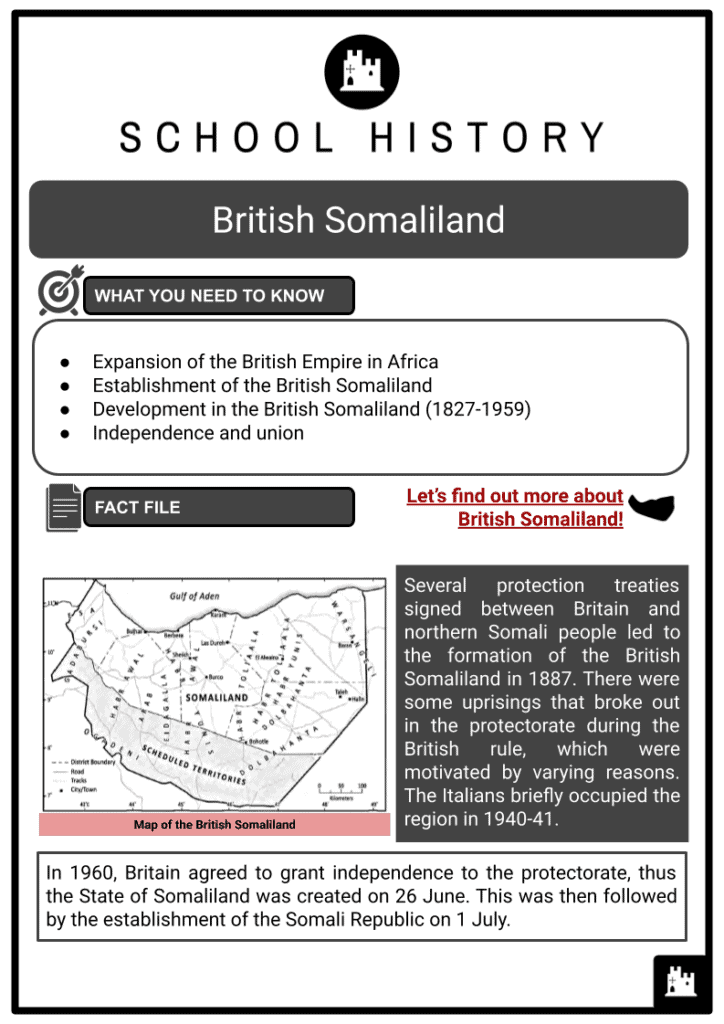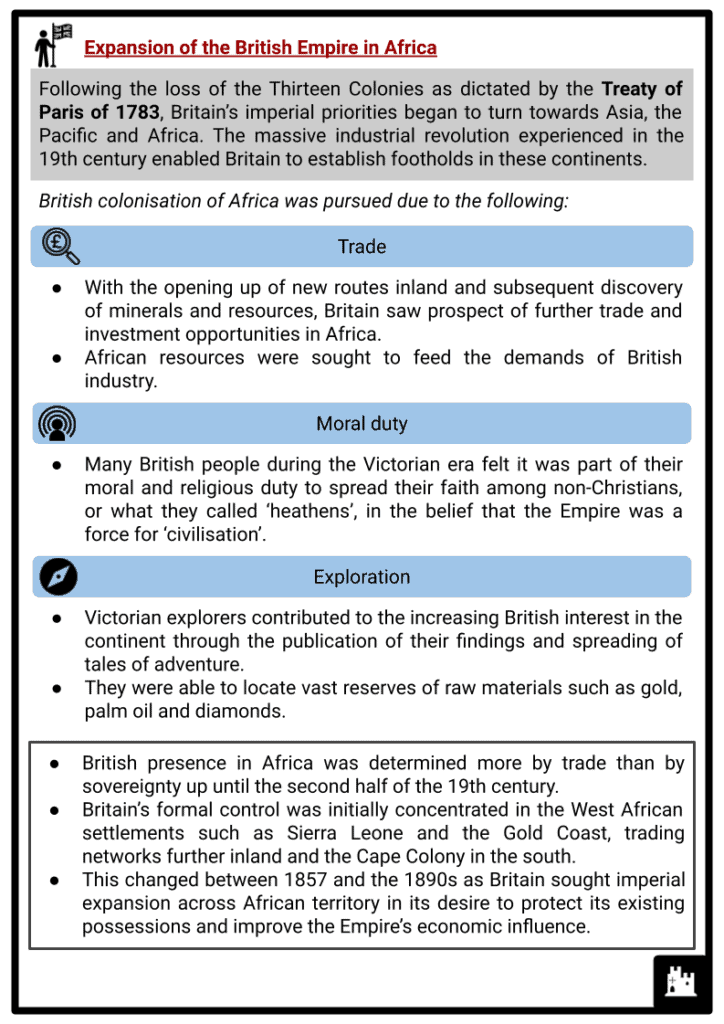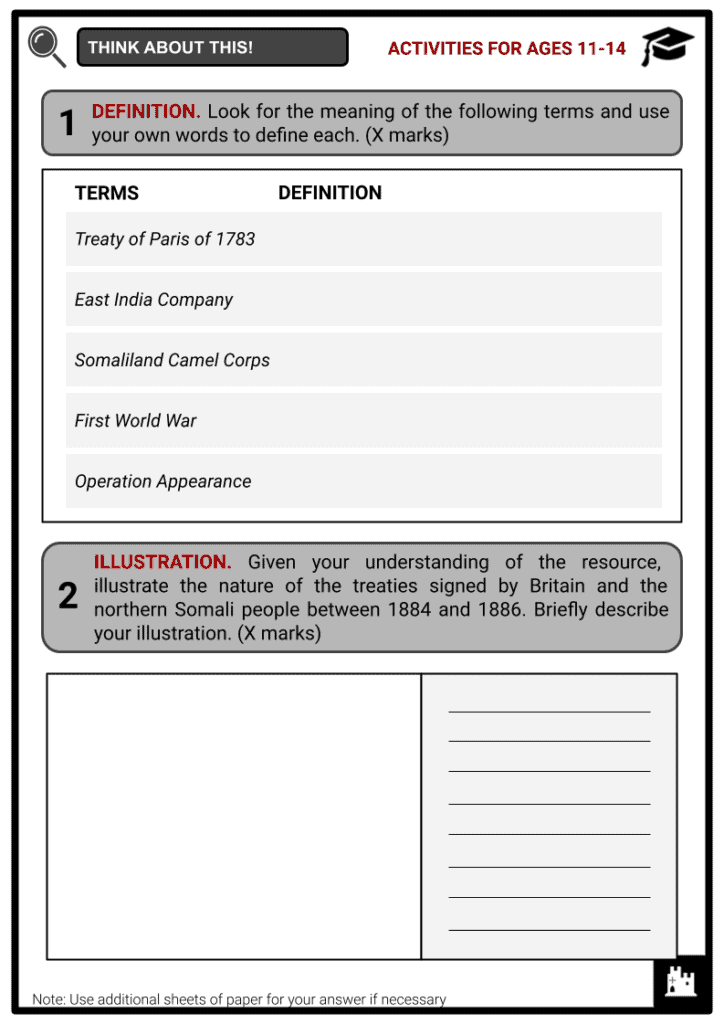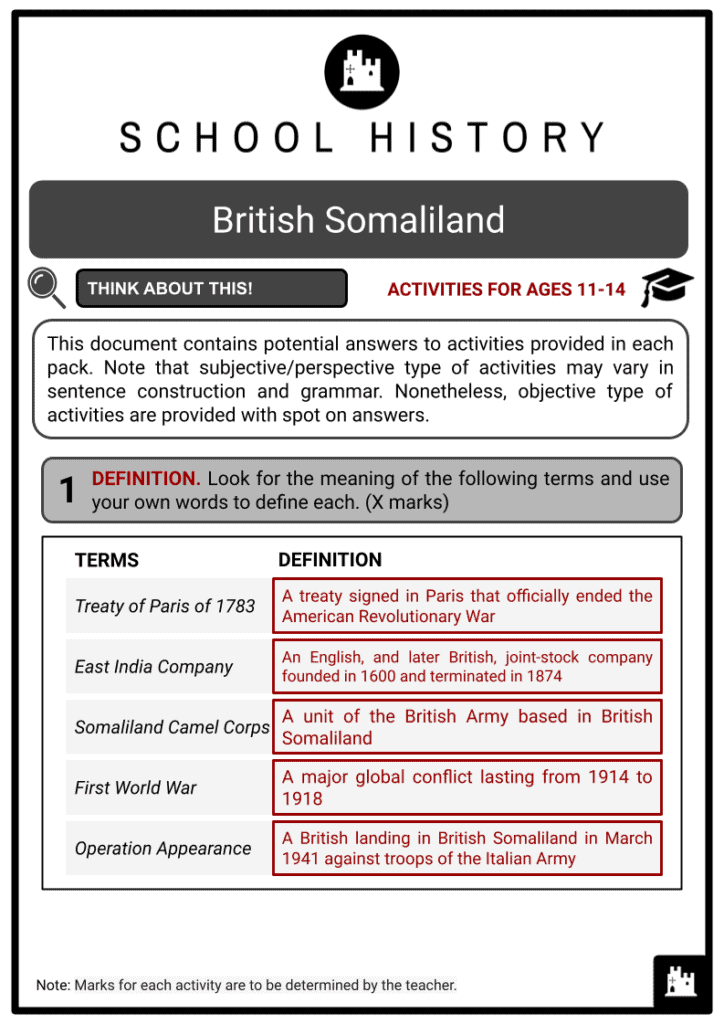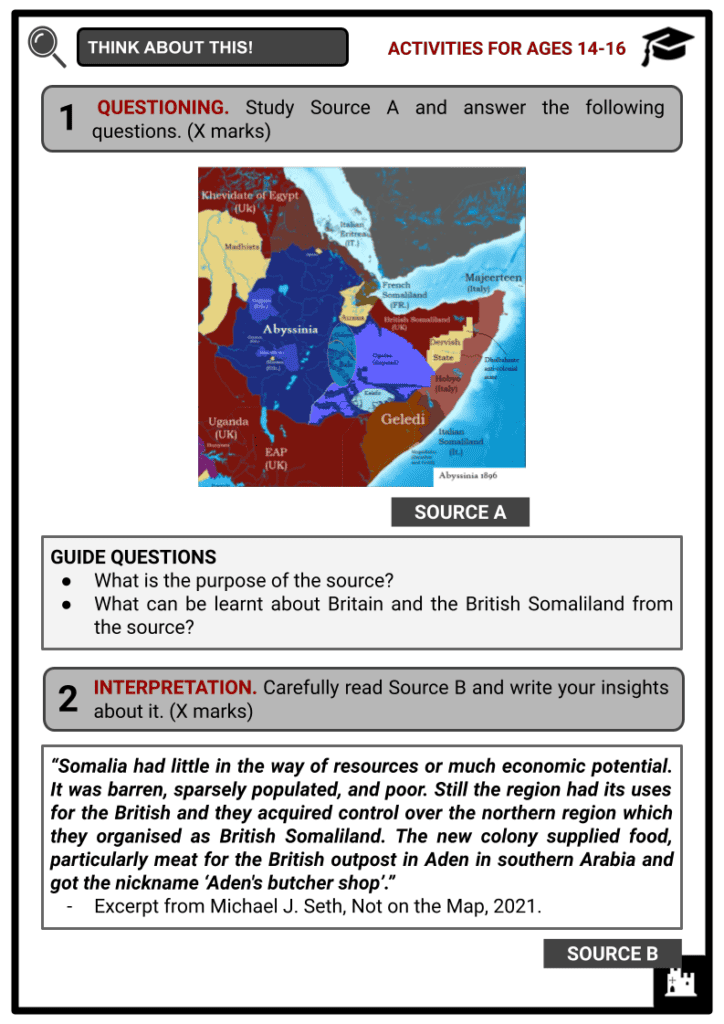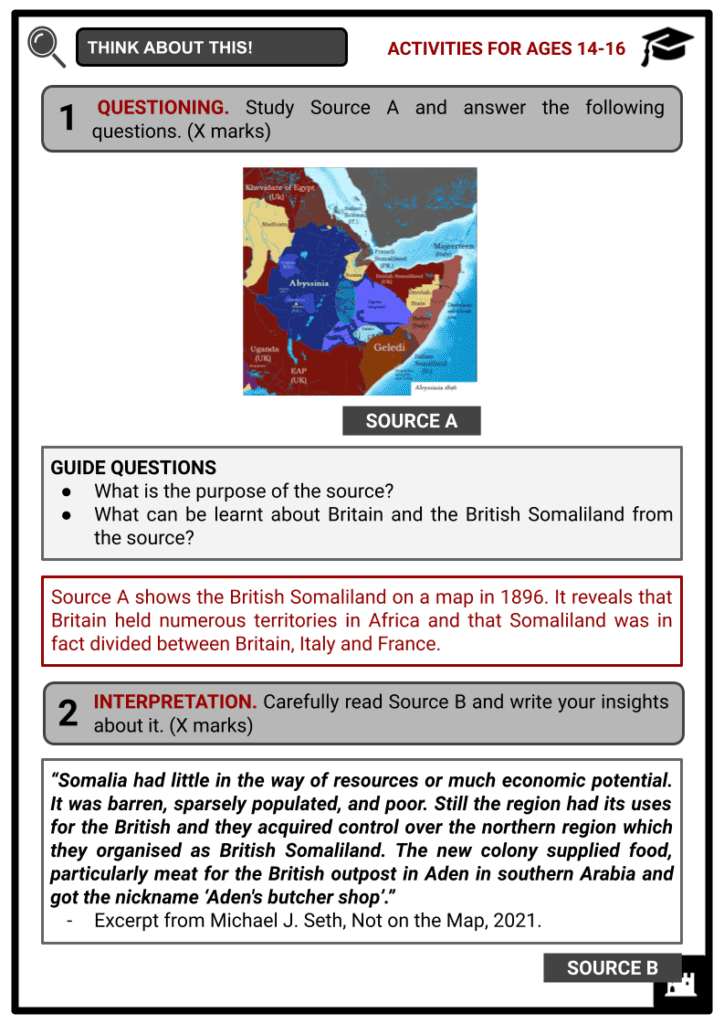British Somaliland Worksheets
Do you want to save dozens of hours in time? Get your evenings and weekends back? Be able to teach about British Somaliland to your students?
Our worksheet bundle includes a fact file and printable worksheets and student activities. Perfect for both the classroom and homeschooling!
Summary
- Expansion of the British Empire in Africa
- Establishment of the British Somaliland
- Development in the British Somaliland (1827-1959)
- Independence and union
Key Facts And Information
Let’s find out more about British Somaliland!

Several protection treaties signed between Britain and northern Somali people led to the formation of British Somaliland in 1887. There were some uprisings that broke out in the protectorate during the British rule, which were motivated by varying reasons. The Italians briefly occupied the region in 1940-41. In 1960, Britain agreed to grant independence to the protectorate, thus the State of Somaliland was created on 26 June. This was then followed by the establishment of the Somali Republic on 1 July.
Expansion of the British Empire in Africa
- Following the loss of the Thirteen Colonies as dictated by the Treaty of Paris of 1783, Britain’s imperial priorities began to turn towards Asia, the Pacific and Africa. The massive industrial revolution experienced in the 19th century enabled Britain to establish footholds in these continents.
British colonisation of Africa was pursued due to the following:
Trade
- With the opening up of new routes inland and subsequent discovery of minerals and resources, Britain saw prospect of further trade and investment opportunities in Africa.
- African resources were sought to feed the demands of British industry.
Moral duty
- Many British people during the Victorian era felt it was part of their moral and religious duty to spread their faith among non-Christians, or what they called ‘heathens’, in the belief that the Empire was a force for ‘civilisation’.
Exploration
- Victorian explorers contributed to the increasing British interest in the continent through the publication of their findings and spreading of tales of adventure.
- They were able to locate vast reserves of raw materials such as gold, palm oil and diamonds.
- British presence in Africa was determined more by trade than by sovereignty up until the second half of the 19th century.
- Britain’s formal control was initially concentrated in the West African settlements such as Sierra Leone and the Gold Coast, trading networks further inland and the Cape Colony in the south.
- This changed between 1857 and the 1890s as Britain sought imperial expansion across African territory in its desire to protect its existing possessions and improve the Empire’s economic influence.
British Expansion in Africa (1857–1890)
- Britain found a particular rival in France, which led to the formalisation of control of the former in areas where British traders had been operating. This was done by chartering companies including the Royal Niger Company, the Imperial British East Africa Company and the British South Africa Company to enforce British claims in the continent.
Establishment of the British Somaliland
- The British first encountered the Somalis of the region in 1825, and this culminated violently in the Battle of Berbera. The British Royal Navy and the East India Company (EIC) immediately dispersed the Somalis, and a trade agreement was made between Britain and the Habr Awal.
- A British treaty with the Governor of Zeila followed in 1840.
- In 1855, the British and the elders of the Habar Garhajis and Habar Toljaala of the Isaaq Sultanate began an engagement.
- This was succeeded a year later by the conclusion of an agreement between the Habr Awal and the EIC.
- Since their first engagement with the Somalis, the British had shown interest in Somaliland from their strategically crucial base at Aden, a port located in the southern part of the Arabian Peninsula.
- Britain had occupied Aden since 1839, becoming familiar with the hostile coast with its slave trading and warring groups of people opposite.
- After the opening of the Suez Canal in 1869, the strategic importance of the area of Somaliland further increased.
- Whilst the area was formally controlled by the Ottoman Empire through its vassal state of Egypt, Somaliland was disorganised and in turmoil.
- When Egypt came under British control in 1882, it meant that the Somaliland area was now technically held by Britain.
- The engagements in the early 19th century between the British and the main northern Somali people resulted in the finalising of their formal treaties which occurred between 1884 and 1886.
- In fact, the British signed protection treaties with the Habr Awal, Gadabursi, Habar Toljaala, Habar Garhajis, Esa, and the Warsangali people, guaranteeing them military support in case of attack from other neighbouring territories.

Map of British Somaliland
Britain sought to establish a protectorate in the region to:
- secure a supply market
- look into the transatlantic slave trade
- exclude the interference of foreign powers
- The arrangements paved the way for the British to institute a protectorate in the region referred to as British Somaliland in 1887 with the intention to protect their trade interests in the Indian Ocean during the scramble and partition for Africa between European nations.
Development in the British Somaliland (1827-1959)
- Colonial administration following the proclamation of the British Somaliland Protectorate excluded administrative infrastructure beyond the coast and was in contrast to the more interventionist colonial exposure of Italian Somaliland. British Somaliland was divided into five administrative districts and British consuls were sent to the coastal towns of Berbera, Bulahar, and Syla.
- British Somaliland was administered by the British resident at Aden as a dependency of the Government of India until 1898.
- Beginning in 1899, the modest rule of the protectorate was threatened by a religious rebellion launched by the Dervish resistance movement. It was led by Sayyid Mohammed Abdullah Hassan known to the British as the Mad Mullah. As a result, the British were forced to expend significant human and military capital to suppress the movement, but repeated military expeditions failed to stop the Dervishes.
- After being administered by the Foreign Office from 1898 to 1905, administration of British Somaliland was transferred to the Colonial Office.
- In 1913, Hassan and the Dervishes were able to defeat Britain’s Somaliland Camel Constabulary at the Battle of Dul Madoba. Half of the Constabulary unit were either wounded or killed. The following year, Britain formed the Somaliland Camel Corps to aid in preserving order in the protectorate.
- Since the protectorate was focused on the fight against the Dervishes, British Somaliland contributed very little to the war effort during the First World War. It was suspected that the Dervishes were aided by the Ottomans and the Germans.
- As early as November 1919, the British started preparations for the fifth expedition against the Dervish forces. Occurring in 1920, the British forces launched bombing raids in the city of Taleh forcing Hassan and the Dervishes to flee to the desert.
- Following the suppression of the Dervish resistance movement, the British shifted their focus to the preservation of stability and the economic self-sufficiency of the protectorate. In order to achieve these aims, heavy taxation was declared to raise revenues for the protectorate’s administration. This was resisted by the people of Burao.
- The Burao Tax Revolt broke out in 1922 with the Habr Yunis men rioting and attacking British government officials. A shoot-out between the British and Burao residents ensued leading to the death of a Dervish war veteran, Captain Allan Gibb. Fearing that the revolt would not be stamped down, local British authorities requested for reinforcements and aeroplane bombers from Aden. The Royal Air Force planes were sent, arriving at Burao within two days and bombing the town. The entire settlement was burnt to the ground.
- The leaders of the Burao Tax Revolt agreed to pay a fine for the death of the British officer but refused to identify the individuals responsible for Gibb’s murder. The implementation of heavy taxation was abandoned, which was regarded as a victory for the Somalis in the protectorate.
- British presence widened to other parts of the protectorate by the 1930s. Advances in commercial trade led some livestock herders to abandon the pastoral economy and settle in urban areas.
- As part of the East African campaign during the Second World War, Italy invaded British Somaliland in August 1940, in which a combined Italian, Eritrean and Somali forces defeated the protectorate’s garrison of British, Commonwealth and colonial forces.
- The capture of the British Somaliland was the greatest victory of the Italians in the East African campaign. During the short-lived Italian occupation in 1940-41, the Ogaden was reunited with southern and northern Somaliland, joining for the first time in a long time all the Somali people that had been arbitrarily divided.
- In March 1941, the British counterattacked and recaptured the protectorate with the success of Operation Appearance. The Italians retreated back to Ethiopia and local troops left en masse. The British placed the British Somaliland under a military administration, with the local police and the Somaliland Camel Corps being reconstituted.
- All resistance from the remaining Italian guerrilla movement in British Somaliland ended by the autumn of 1943.
- In July 1945, another uprising known as the Sheikh Bashir Rebellion broke out in the protectorate. The Habr Je’lo men led by the Somali religious leader Sheikh Bashir opened fire on British authorities in the cities of Burao and Erigavo. Several campaigns by the British against the rebels proved unsuccessful as Sheikh Bashir’s forces moved from place to place. The British authorities mobilised a police force that was joined by Indian and South African troops. The leader of the rebellion and his second-in-command were killed in the clashes, as well as a number of British colonial troops. The British continued their counter-insurgency campaign despite the death of Sheikh Bashir.
- At the end of the Second World War, four of the Somali-inhabited territories except Djibouti, a French colony, were under the British rule. In 1957, a Legislative Council and an Executive Council were established in British Somaliland. In 1959, elections to the Legislative Council were set up.
Independence and union
- The Legislative Councils of both the British Somaliland and the Trust Territory of Somaliland held a joint conference in Mogadishu and agreed to be united into one country. In April 1960, the Legislative Council of British Somaliland passed a resolution requesting independence and subsequent union with the Trust Territory of Somaliland as agreed.
- In May 1960, the British government expressed their plan to grant independence to the protectorate. They initially thought to delay the granting of independence believing that a gradual transfer of power would enable the local politicians to acquire more political experience in the administration of the territory.
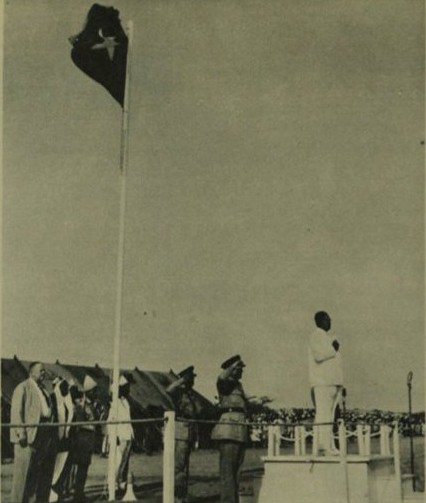
The State of Somaliland Flag at the Independence Celebrations on 26 June 1960 - Strong pan-Somali nationalism and the demand for immediate independence urged Britain to acquiesce.
- On 26 June 1960, the British Somaliland gained independence as the State of Somaliland.
- The Trust Territory of Somaliland was due to acquire independence five days later.
- On 27 June 1960, the newly convened Somaliland Legislative Assembly passed a bill that would formally enable the union of the State of Somaliland with the Trust Territory of Somaliland.
- The brief period of independence of the State of Somaliland earned the recognition of numerous sovereign states.
- On 1 July 1960, the State of Somaliland and the Trust Territory of Somaliland united as intended and formed the Somali Republic. Aden Abdullah Osman Daar became the first president and Abdirashid Ali Shermarke was the first prime minister of the new country. The ratification of a new constitution first drafted in 1960 followed in July 1961.
Image Sources
- https://upload.wikimedia.org/wikipedia/commons/thumb/1/1e/Map_of_Somaliland_Protectorate.jpg/1024px-Map_of_Somaliland_Protectorate.jpg
- https://upload.wikimedia.org/wikipedia/commons/3/3d/Somaliland_clans.jpg
- https://upload.wikimedia.org/wikipedia/commons/0/0b/Somaliland_Flying_for_the_first_time_The_White_and_Blue_Somali_Flag_at_the_Independence_Celebrations_on_26_June_1960.jpg
Frequently Asked Questions
- What is British Somaliland?
British Somaliland was a British protectorate located in the Horn of Africa. It existed from 1884 to 1960 and was situated in the northern part of present-day Somalia.
- Why did Britain take over Somaliland?
Britain took over Somaliland as a colonial protectorate primarily for strategic interests, aiming to secure control over maritime trade routes in the region and ensure access to the Indian Ocean.
- When did British Somaliland gain independence?
British Somaliland gained independence on 26 June 1960. It briefly united with the former Italian Somaliland on 1 July 1960 to form the independent Somali Republic.

